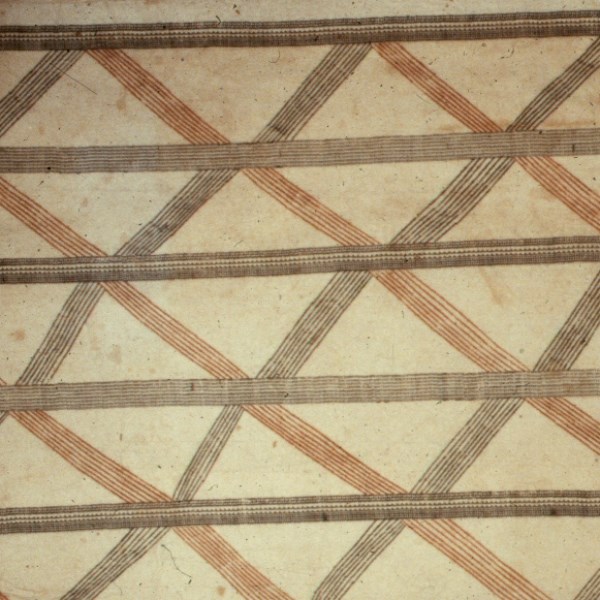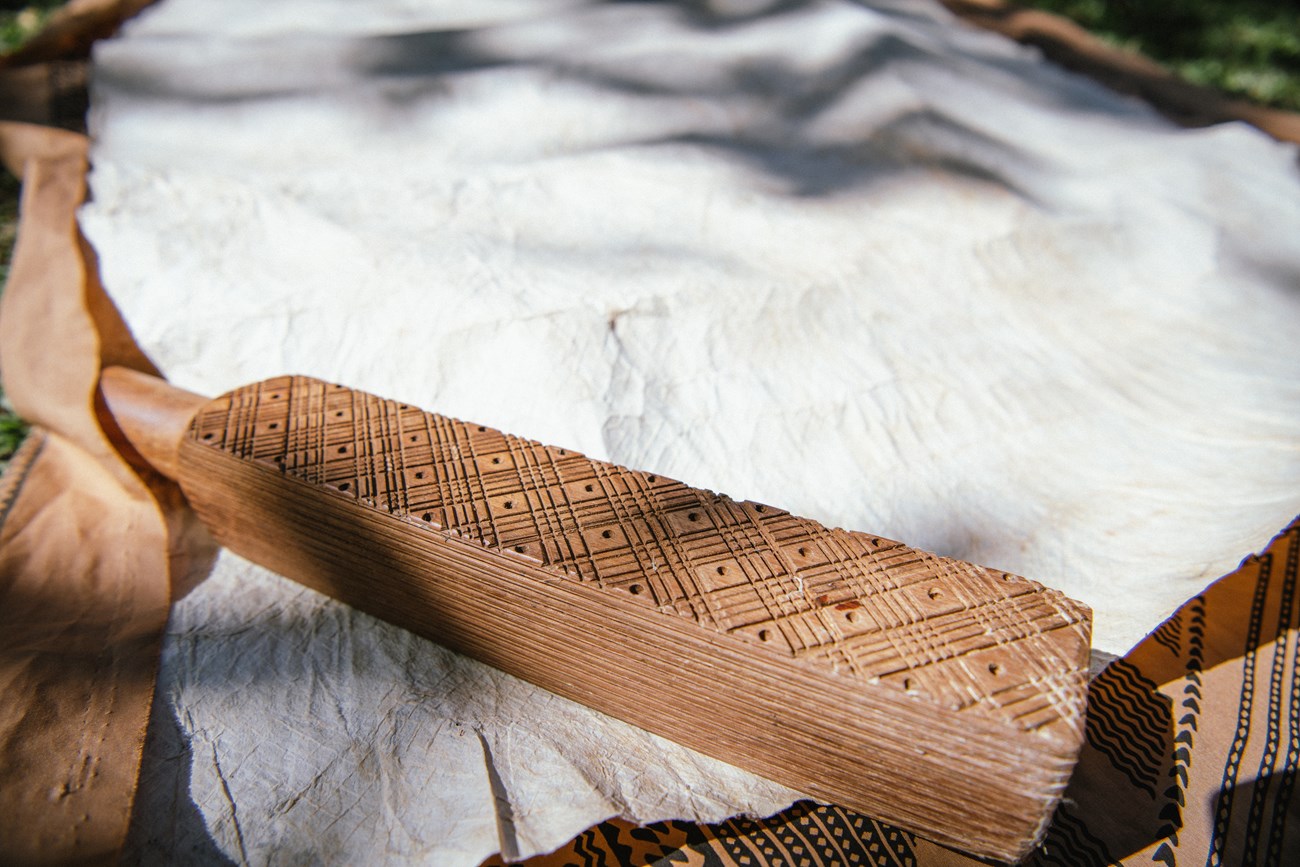Part of a series of articles titled Home and Homelands Exhibition: Work.
Article
Iʻe kuku and Kapa Making Workshop
- Duration:
- 1 minute, 26 seconds
A group of women demonstrate how to make Kapa (Hawaiian barkcloth).
Article by Nicole Martin, PhD
On a sunny day in April 2023, a group of women came together at Haleakalā National Park to demonstrate kapa making.1 They are part of a modern kapa revival that breathes new life into what was once believed to be a lost art.
Kapa (Hawaiian barkcloth) is a centuries-old Polynesian textile (known as tapa elsewhere in the Pacific) that early Hawaiians elevated to a high art by adding fermentation, watermarks, and bold natural pigments to the process. Before the introduction of cotton to the Hawaiian Islands in the nineteenth century, kapa was everywhere. It clothed the living, covered the sleeping, buried the dead, and beautified the ceremonial dress of dancers and warriors. It also, journalist Shannon Wianecki points out, contained “a spiritual dimension; it held the mana (life force) of the plants it was made from and the persons who made and wore it.”2

Bernice Puauhi Bishop Museum.
In the video, the women create a pleasant hollow beating sound by striking wauke (paper mulberry) with nā iʻe kuku (wooden kapa beaters) on wooden anvils. While watching the women work, you may be drawn to their concentration, their strength, or their tranquility. They seem to simultaneously observe, reflect, listen, practice, and share in the space created by the rhythmic pulsing of the iʻe kuku as they shape the kapa to their liking.
The Kapa Beater and Women’s Work
'Ōlelo Noʻeau E lawe i ke aʻo a mālama, a e ʻoi mau ka naʻauao.
He who takes his teachings and applies them increase his knowledge.3
Traditionally, kapa making was women’s work. It is also arduous work. A single piece of kapa can take months to complete. While every kapa maker’s process differs in the details, a similar process is generally followed. After the paper mulberry plant has been carefully cultivated for up to two years, it is stripped of its bark. Then large blocks of time must be set aside to beat and shape the bark through various stages, using tools made primarily from native wood. Finally, Native Hawaiian and Polynesian plants are commonly used to scent and boldly dye the kapa.
The video of the women focuses on an important beating stage that occurs after the wauke has gone through a soaking and fermentation process. At this point, the bark is struck with the iʻe kuku implement. On the iʻe kuku displayed below, one side contains an intricately carved pattern that is used for the finishing beat in order to impress a unique watermark onto the cloth. The watermark not only personalizes each piece but also reflects the vision, experiences, and environment of each kapa practitioner.

NPS / Jill Peters
Sound of Home
In the video, the ʻouʻou, the sound of the iʻe kuku striking on the wooden anvil, is ever present. It is the sound of music and labor blended together. Early Hawaiians may have even communicated through the beating, relaying messages and news across the island.
It is a world of sound that European and American colonization almost entirely wiped out.4
When imagining what makes a home and what gives meaning to a homeland, sound is often overlooked. But sound can make us feel at home just as much as a structure, a landscape, an object, or a tradition. The contemporary kapa revival in Hawaiʻi is nothing less than an astonishing restoration of a lost soundscape. Each beat recalls a pre-colonized homeland while also creating a new soundscape and new visions of home in the present.
For Native Hawaiian women like Didi, Poha, and Kapiʻolani, the act of kapa making can transport them to the past. The familiar rhythmic pulsing of the iʻe kuku establishes a meditative space that provokes questions about how female forebearers made kapa and what they might have thought about as they worked.5 It is an opportunity, while rooted in one spot for hours at a time, to think about who has also called this space home before and who it will be home to in the future.
In this sense, the hollow ʻouʻou powerfully links women of the past, present, and future.
1 Kapa Workshop at Kīpahulu District of Haleakalā National Park, April 14, 2023.
2 Shannon Wianecki, “Beauty in the Bark,” Maui Nō Ka ʻOi Magazine, January 1, 2014.
3 This quotation and all references to the kapa making process are from the April 2023 Kapa Workshop at Kīpahulu District of Haleakalā National Park, notes provided by Didi Krause.
4 William Tufts Brigham, Ka Hana Kapa: The Making of Bark-cloth in Hawaii, Vol. III (Honolulu, H.I., Bishop Museum Press, 1911), 78.
5 For one kapa maker’s experience of being transported back in time through the sound of the kapa beater, see Marlene A. Zeug, “An Oral History of Three Generations of Kapa Practitioners,” PhD. diss., (University of Hawaiʻi at Mānoa, 2017), 254-55.
Last updated: June 11, 2024
